
Wound Dressings Page Menu: 1 2 3 4 5 6 7 8 9 10 11 Next>>
Wound Dressings in the Golden Age of Piracy, Page 3
Medicinal Tents
Medicinal tents are inserted into a wound to keep it open. Lorenz Heister describes tents as pieces of cloth "worked into the shape of a Nail, with a broad flat Head"1.
Pierre Dionis identifies four that things tents do for the surgeon and the patient. "The first is to convey the Remedy, and keep it applied to the deepest part of the Wounds; The second, to absorb the corrupting Sanies [serum, blood and/or pus which is discharged by wounds], which easily filter through the Pores of the Tents, by which the Air is also rarified by the heat of the Part: The third is to keep the Wound open, and prevent the Lips re-uniting before the bottom is fill’d [with regrown flesh]; and the fourth is that of drawing forth the Matter which ought to come out, whence they are always plac’d at the lowest part of the Wound."2
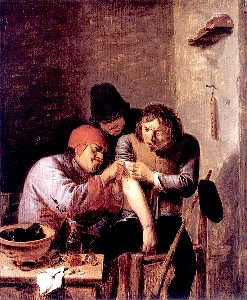
Feeling by Adriaen Brouwer (1635)
Dionis goes on to give several reasons why some period surgeons did not believe in using tents and then answered each.
The first argument against their use was that they caused pain, which "ought to be avoided, lest they [the tents] be follow'd by Fluxion [release of pus and other matter from the wound] and Inflammation"3. While he agreed that "above all things, the Patient ought to be exempted from Pain as much as possible", he explained that the surgeon could easily "make the Tents small, equal, and so even that they may not hurt at all."4
Second, tent detractors felt that "by their hardness they fret and bruise the Flesh; which being depriv'd of the Skin, is very tender"4. Dionis answered that he couldn't "apprehend how Tents can make any Contusion in a Wound; for they ought to be so soft as to yield easily to the natural Course of the Parts"5. As we shall soon see, tents were made of different materials depending on the application. Softer tents could indeed be easily made if they fit the purpose.
"Thirdly, they alledge, that Tents stopping the Mouth of the Wound, keep in the Sanies which corrodes and widens it"6. To this, Dionis replied that "a Tent drying up the Sanies prevents the Wound from growing Ulcerous and Cavernous; and if there happen to be so much [sanies], that the Tent, or the Plumaceoli or Plegets cannot absorb it all, more frequent dressing is necessary" or the tent must be designed so that the sanies could get out of the wound.7
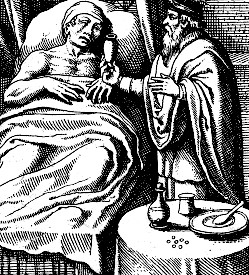
Administration de Efficaci Medicina Libri Tres,
by Marco Aurelio Severino, Title page (1646)
Last, the opponents of tents noted that "whatever hinders the closing of the Wound is to be avoided; but Tents put into it, prevent its Re-union; the use of them, conclude they, ought therefore to be retrench'd...
To answer the fourth Reason, I say, that if we keep the Tents too long in the Wound, we prevent its Re-union; but they are put in at first to draw out the exotic Bodies, the clotted and extravasated [leaking] Blood: Next, when 'tis regulated, and the Flesh is come to a beautiful Vermilion Colour, the Tents are taken out, in order to leave the Wound to cicatrize [heal over with a scar]. Thus the Resolution of the Question depends on knowing the proper time when to use, and when to reject them."8
Much of the problem with tents appears to have been caused by their incorrect application. Richard Wiseman reported a case where he was preparing to dress a patient's wounds when he "pull'd a Tent, near two inches long, and proportionally big. The other [wound] was a Puncture on the outside of the Arm, with a Tent crowded into it. I dressed this latter Wound with a Pledgit [small piece of lint - see the next page for more on pledgets] spred with a Digestive ex terebinth. [turpentine] & empl. é bolo , and in two or three dressings cured it.
To the other I applied some of the same Digestive upon a small Tent; and having embrocated the adjacent Parts with ol. ros. [oil of roses] I used empl. é bolo [a plaster composed of oil, litharge or elemental lead, and bole or argillaceous earth] with Compress and Bandage, and designed that way to cure it. But the Sinus [cavity] being depending, and the Wound disturbed by the unreasonable great Tent, hindered the Agglutination [healing of the lips of the wound]: wherefore after a dressing or two I snipt it open with a pair of Probe-scissors, and cured it by incarning [forming tissue in the wound], &c."9
1 Lorenz Heister, A General System of Surgery in Three Parts, p. 17; 2 Pierre Dionis, A course of chirurgical operations: demonstrated in the royal garden at Paris. 2nd ed., p. 18-9; 3,4,5,6,7,8 Dionis, p. 19; 8 Richard Wiseman, Of Wounds, Severall Chirurgicall Treatises, p. 369
Medicinal Tents: Composition
:Dionis identifies five materials that were used in the makeup of medicinal tents: Lint, Linen, Sponge, Silver and Lead.1 Note that the last two are actually used to create small pipes that allow the wound to drain, but since he refers to them as tents, we will do likewise.He explains that lint tents "are the easiest and softest, and less fatigue the Sore than the others: They are made use of to convey a Remedy to the bottom of the Wound, and imbibe the liquid or corrosive
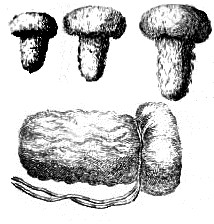
Lint Tents, from A General System of
Surgery by Lorenz Heister,
Plate 2, p. 20 (1750)
Matter [formed in the wound], and by that Means, prevent the Excrements injuring the Part."2 Lint was made by hand by pulling worn cloth apart fiber by fiber as we'll see when discussing pledgets. In fact, the pledget that Wiseman talks about in the previous section would probably be indistinguishable from a lint tent based on Dionis' description.
"Those [tents made] of Linen are generally the roughest of all; they are long and hard, shap’d like Nails, whose heads are thicker and broader than the rest, to prevent their entring the Cavities of the Breast or Belly, where they are frequently made use of."3 Although Dionis suggests that linen tents would be restricted to particular operations, linen was one of the most commonly mentioned materials for use in medicine. While lint could be made, it was a time consuming process. One can't help but wonder if some surgeons might have used linen inside of a wound for ease, causing the damage reported by the naysayers in the previous section.
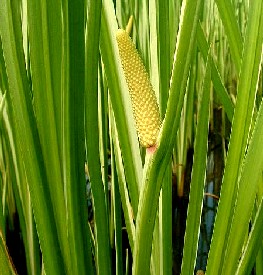
Photo: J.F. Gaffard
Calamas Armoaticus aka. Acorus Calamus
Sponge tents sounded rather unusual and you have to wonder why they would be used at all. Dionis explains such a tent was "boil'd in a Liquor [liquid] in which is Wax; after which, whilst hot, 'tis bound with a small twisted Band, to give it the form of a Tent. When a Wound is to be dilated, one of these Tents is put in, which so swells with the Humidity of the Ulcer, that 'tis hardly to be got out again."4
He suggests that their use was "proper on some occasions, but the continual Use of them would be very dangerous; by reason, that in their swelling they grow so hard, that, by their Compression, they may render the Parts which they touch Schirrous [hard and dense] or Callous."4 Note that he doesn't explain on which occasions they would be proper, giving impression they were best avoided. Lorenz Heister classed sponge tents with others he said had similar properties that were made "of dried Roots of Gentian [Gentiana lutea or bitter root], Calamus Aromaticus [Acorus calamus], &c."5 Yet, he shows no drawings of them, hinting that they weren't widely used.
Dionis also identifies metal pipes as being tents, or at least like them in shape enough to be grouped together with them. These were basically used as drains to allow fluids to escape from deep wounds. Structurally, they are tubes which "are pierc’d according to their whole lengths"6. Their design allows them "to convey Matter outwards contain’d in great Cavities [of the body]; and have this Conveniency besides, that with a small Linen which stops them, the Patient may be dress’d without removing them out of the Wound."7 Dionis says that such tubes are made of two materials: silver and lead, apparently chosen because of their softness, allowing them to bend once installed.
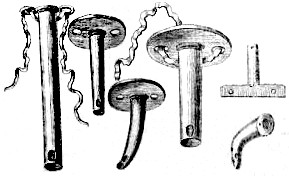
A Variety of Surgical Drains, from A General System of
Surgery by Lorenz Heister,
Plate 2, p. 20 (1750)
He spends some time comparing the advantages of silver to lead and vice versa. He believes "that a Silver Tent would less hurt the Patient, because it would better retain its Shape, as being of a harder Substance; besides which, the Separation of Metally Corpuscles is less to be fear’d by the Corrosion of the Juices."8
This hints that Dionis grasped the problems of lead poisoning. While lead poisoning was not completely understood at this time, it was recognized as a potential health hazard. As early as 1656, German physician Samuel Stockhausen maintained that exposure to lead compounds lead to a disease that had been called morbi metallici since ancient Roman times.9
Even so, Dionis explains that lead was "by some Persons [surgeons] preferr’d to all other Metals, as being the most kindly to Men, since we have seen Bullets of it remain a whole Life in the Bodies of several Persons without incommoding them; but besides that, these Balls could not remains so long there without hurting them, were it not that their Figure adjusts it self to the Places where they are lodg’d, and that they were found to be without the Action of the moving Fibres, and the Course of the Liquors [fluids in the body]"10. In addition, he feels that lead allows "the Chirurgeon may himself shape his Tents, when no Silversmith is at hand to make them of Silver, or when the Patient’s Circumstances are too mean to bear the Expence."11 This last comment is quite relevant to sea surgeons who would not have ready access to silversmiths and who were treating patients who would hardly be able to afford silver tubes even if they could get them.
1 Pierre Dionis, A course of chirurgical operations: demonstrated in the royal garden at Paris. 2nd ed., p. 17; 2 Dionis,p. 17-8; 3,4 5 Dionis,p. 18; 6 Lorenz Heister, A General System of Surgery in Three Parts, p. 18; 7,8 Dionis,p. 18; Lead poisoning - History, wikipedia, gathered 9/12/12; 9,10 Dionis,p. 18
Medicinal Tents: Their Form
Charles Gabriel Le Clerc explains how to create a tent in a straightforward manner. "Great Tents of Cloth are made of small square Bits of Raggs, in this manner: Take one of these by its Angles, and roll it between the Thumb and Fore-Finger of the Right Hand, so that one of its Ends be pointed, and that the other grow bigger; then take another of these Raggs, and roll it on the former, and continue to do thus till the Tent be thick enough; but the lesser End to make it blunter, for fear it hurt the Parts; snip the thick End transversally; then give it a Cut with your Scissors length-ways, for the forming a Head or Cap; and lastly tie it with a Thread of Lint."1
While simple, Le Clerc's description doesn't go into much detail as Pierre Dionis. Dionis once again details a large variety of tents and pipes. He provides us with more insight into their makeup and use, so I am going to quote his entry in full to give greater insight into their makeup.
"[T]he first, A, is very little, 'tis made of Lint rolled up, so that its Head is of the same Fashion with the rest, 'tis used in the opening of small Abscesses, being accompanied with a small quantity of some Mundificative [a softening medicine] to cleanse the Flesh corrupted by the continuance of the Matter there.
The second, B, is thicker and longer than the precedent, and is made of Lint, with a Head to prevent its sinking deeper than is intended; 'tis soft that it may not hurt, and yet substantial enough to make its way, and keep the Wound open; 'tis usually wetted in some Liquid, or cover'd with some Unguent; 'tis very proper for several Wounds, particularly those which are called Green.
The third, C, is also of Lint, and is much larger than the former, and of an equal thickness throughout its whole length: The dexterity of the Chirurgeon clearly appears in the making of these Tents, for all of them don't equally succeed: They are apply'd to several Wounds, and particularly are thrust into the Anus after the Operation of the Fistula.
The fourth, D, is a Tent made of several small bits of Linen rolled over one another; the Point is blunted, and somewhat un-spun, or pulled out, that it may not offend the Parts which it must touch, and tho' it has a large Head made of the same Linen, it hath always fasten'd to it a Thread long enough to hold it, in case it would fall into any
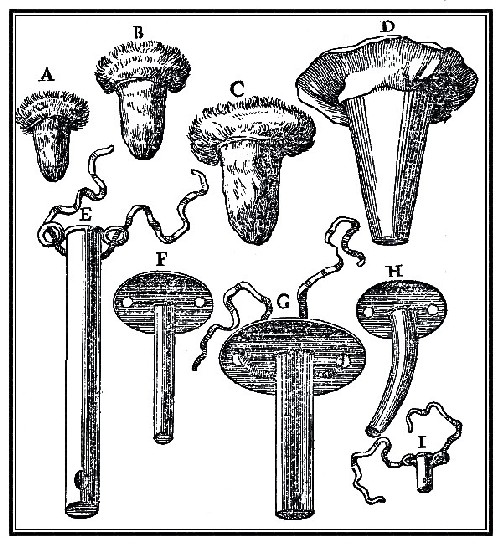
Of Tents, A course of chirurgical operations, by Pierre Dionis, Table 3,p. 17 (1733)
Cavity, it being used in Sutures of the Belly; 'tis apply'd to the lower part of the Wound, in order to keep up a continual issue of the Matter.
The Great Pipe, E, is, as well as the following, of Silver, and has two small Rings on the two sides of the Head, thro' which is run a narrow Ribbon to keep it fast in the Wound; and tho' 'tis bored from one end to the other, there are besides two little Holes at its interior Extremity, to let the Urine or Matter run off, when the Membranes of the Bladder, the thin Skins, or Clots of Blood entring at that end, stop it. This Pipe is chiefly made use of after Lithotomy [removal of stones from the kidneys via the anus], or the Punction of the Perminæum [parineum - the region between the thighs, bounded in the sex organs and the anus].
There is another, F, which is called the Flat Pipe, by reason it has at its Head a little round Place with two little Holes, thro' which a Tape or Ribbon is run: It is used in an Empyema [pus collected in between the lung and the inner chest wall] or Paracentesis [an operation to relieve abdominal pressure], in which case it's preferable to those with Rings, the Matter and Water being better retained by a Plate applied exactly to the Skin around the exterior Orifice of the Wound which is made.
That marked G is a Flat Pipe, provided with a Plate as well as the former, from which it differs only in its Body, being Oval like a Cylinder, flatted on the sides, whereas the precedent is as round as a common Cylinder; and 'tis requisite it should be so, in order to serve when such Subjects occur as are so closed, that we cannot dilate an Orifice wide enough to admit a round Pipe.
The Pipe, H, stands bent, and has also a Plate intended for the same use with that of the others. The Body of this Pipe is bent, in order to adapt it to such Wounds as will not properly admit the use of the straight one.
The last, I, is a very small Pipe with two Rings at its Head; and the End, which is to enter the Wound sideways, has two Holes, the one bored above the other, for the Passage of the Air which enters by the Mouth after the Operation of Bronchotomia, for which the Instrument is particularly design'd."2
3 Charles Gabriel Le Clerc, A Description of Bandages and Dressings, p. 10; 2 Pierre Dionis, A course of chirurgical operations: demonstrated in the royal garden at Paris. 2nd ed., p. 19-20
Medicinal Tent Usage: As Diagnostics
In addition to the number of uses in wounds that have already been mentioned in previous sections, tents could be used as diagnostics. This was done by the surgeon when he removed a tent from the wound. By examining what came out with the tent from inside the wound, the surgeon could get an idea about how the healing was proceeding.
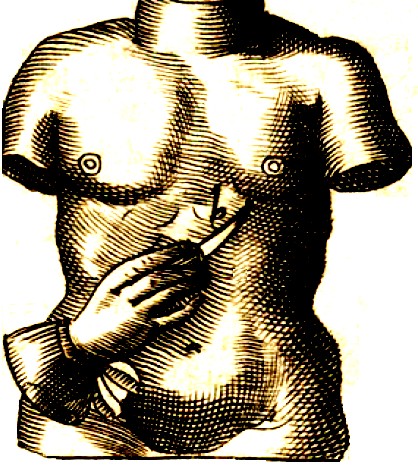
Abdominal surgery from The Chyrurgeons Storehouse by Johannes Scultetus,
Table 37,p. 163 (1653)
Matthias Gottfried Purmann provides an explicit example of how this was done. In his account he was treating the Son of Nobleman De la Genevrage who had received a sword wound between his fourth and fifth rib. He began by bleeding the man copiously to relieve him of bad humors that may have gathered.
"However, this plentiful evacuation could not prevent a Fever, which seized Him on the Sixth day, and continued with great violence till the Fourteenth, attended with a Cough which increased every day, and was a dangerous symptom. The Tent came out of the Wound very Black, and yet there was no sign at all of any corruption in the Cavity of the Breast. The Fifteenth day the Cough abated. The Seventeenth a Substance partly Fleshy partly Membranous but very rotten came out of the Wound, with above three Ounces of bloody coagulated Matter, after which the Tent never look'd black again as before."1
John Moyle even uses the matter on the tents to tell him how to design the tents. "You may know when the Wound incarns by a red speck that will be at the point of your Tent when you take it out, and then must your Tents be made shorter."2 Presumably, the red speck was blood or some other serum that got on the bottom of the tent when the wound had grown flesh upwards to the point where it touched the tent.
1 Matthias Gottfried Purmann, Chirurgia Curiosa, p. 129; 2 John Moyle, The Sea Chirurgeon, p. 76
Medicinal Tent Usage: Gunshot Wounds
Gunshot wounds seem to have universally been treated with tents. Several surgeons recommend them, probably because the wounds were often deep and required a great deal of wound incarnation. A tent would keep the wound open, assuring that the lips didn't heal over and create an abscess. Sea surgeon Hugh Ryder used tents as the primary dressing to heal such a wound at sea.
"A Sea-man received a Wound by a Musquet-ball... Running to me almost strangled, and not able to speak, he made sign of being choakt with his Finger, whereupon feeling the Bullet, I made incision,
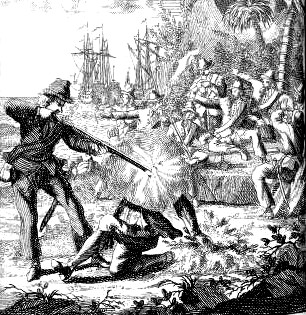
Edward Low Shoots a Man, from the Dutch edition of the
General History of the Pyrates by Charles Johnson (1725)
and taking it out gave it him, scarce willing to stay to be drest, only I clapt into the Wound above the Scapula [shoulder blade], a short thick Tent of dry Tow; he went to his quarters again, and behaved himself with a great deal of courage, till the fight was over; the wound made by Incision proved but little troublesome, for that easily healed; and that on the Shoulder after it came to be well digested (the quantity of matter daily decreasing) short Tents being still applied, in about three Weeks was perfectly Cured."1
Moyle provides more detail on how tents were to be used in the bullet removal operation. He explains that once the bullet has been removed, "keeping the Man in the same posture still [as when he was shot], take a Tent dipt in Acetum [a plaster of oil, litharge and copper salts kneaded with hydrocholorine and olive oil], or Aq. Stipt. [Aqua Stypitica – zinc and copper sulfate in rose water used as a restringent] And then rouled in Pulv. restring.maj. [powdered medicine to stop bleeding] and apply it into the Wound; let it be so long as to reach almost to the bottom of the Wound, that the Medicines may touch any Vessel that is divided or wounded by the way. And if the Shot went quite through, or were cut out on the contrary side, then the Tent is at both Orifices, and dip your double bolster in Acetum, to reach about the part, and so make decent rouling [application of roller bandages]"2.
Matthias Gottfried Purmann gives a similar prescription, while also noting that the tent "must be made of nothing but Lint, proportioned to the Bigness of the Wound, that the Matter and Corruption, of which these Wounds breed abundance, may have Liberty to issue out"3.
This treatment didn't always work. however. Sea surgeon John Atkins gives us this harrowing account:
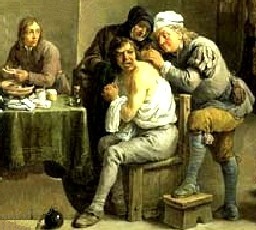
Artist: David Teniers the Younger
"To the [gunshot] Wound we used a short soft Tent, moistened with a Digestive [substance to promote flesh formation], and Embrocation [moistening agent] of Ol. Rosar. [Oil of roses] warm, and the Cataplasma resolvens [a lead-based plaster used to reduce swelling], the Bandage for a compound Fractures, and a proper Situation.
The Pain notwithstanding became in a manner agonizing; and what compleated the Misfortune, instead of Incision, a thick dry Tent was thrust in to dilate the
Wound, and give a free Vent to this bloody Serum, which was not in greater Abundance. This had all the ill Effect that could be the Tumor and Inflammation were extravagantly increased by next Day, the Limb convulsed, and Spasmus Cynicus [a convulsion that causes the patient to imitate a dog!] followed.
We made a warm Embrocation of the affected Part, and down the Spine... Breathed a Vein [bled the patient], and gave a quieting Potion; but to no Purpose. He continued so for twenty-four Hours, and died the fourteenth Day from receiving his Hurt."4
Of course, the tent was probably not to blame for all of this patient's misfortune. As Purmann notes, "you must always give this sort of Wound [gunshot] sufficient Vent. That [way] they may sooner and better come to Suppuration."5 Given that wound suppuration was the intentional formation of pus, which was thought to be the bad humors leaving deep wounds, the infection which that pus indicated was probably more responsible for 'extravagantly increased' inflammation than the 'thick dry Tent' that was 'thrust in.' It's really quite amazing that so many patients actually survived this treatment.
1 Hugh Ryder, New Practical Observations in Surgery Containing Divers Remarkable Cases and Cures, p. 82-3; 2 John Moyle, The Sea Chirurgeon, p. 74-5; 3 Matthias Gottfried Purmann, Chirurgia Curiosa, p.185; 4 John Atkins, The Navy Surgeon, p. 71-2; 5 Purmann, p. 186

